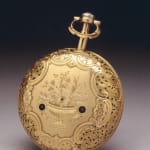Daniel de St Leu
A superb and very rare George III gold pocket watch made for the Turkish export market signed on the white enamel dial De St Leu London and also signed and numbered on the movement and dust cover 4040 Dan de St Leu Watch Maker to her Majesty London. The dial with Turkish numerals and a fine pair of gilt brass hands for the minutes and hours with an antique cut diamond set into the top of the winding handle. The full plate two-train fusee movement, with chains to the fusee, verge escapement and very rare self striking mechanism sounding on hours and quarters, the dust cover cut out for fine adjustment. The beautifully elaborate triple case with outer case of tortoiseshell overlaid with gold scroll and pin work, the middle case with pierced floral decoration and an engraved floral-filled basket and inner dust case with open scroll work, with original flat centred glass and a small lever positioned at 3 o'clock with the option of strike/silent
London, date circa 1780
Height 6.5 cm.
Daniel de St Leu (active 1753-97) produced some of the most exquisite and elaborate watches of the eighteenth century. Gaining royal favour, he was appointed to Queen Charlotte, wife of King George III in 1765 and held this title for the rest of his life since all his watches after this date are either signed 'Sevt. to her Majesty', or as here 'Watch Maker to her Majesty'. He was also one of a surprisingly large number of London watch makers to cater for wealthy Turkish customers who wanted their watches to be pieces of jewellery, preferably of gold, richly cased and studded with diamonds. Two of his watches are still in the Saray, one with richly decorated hands, and the other encrusted with diamonds. The Louvre Paris also possesses a diamond-studded watch by him owned by the Dey of Algeria, which was taken by the French at the conquest of Algiers, 1830. Another of his diamond and gold watches for the Eastern market has a remarkable arrangement of musical instruments, all of a distinct martial character (sold in London 1966).
First recorded working in London in 1753, Daniel de St Leu was based at the sign of 'The Golden Head' in Cloak Lane (later known as 17 Cloak Lane). He subsequently moved to 38 Cornhill, where in about 1790 his business was succeeded by the firm of Rivers & Son (who operated from 1782-1815). De St Leu either retired of possibly died in 1797.
The present watch is typical of his fine quality of craftsmanship. Not only is it beautifully ornamented but is self-striking - 18th century striking watches are rare, returning in favour for a while during the later part of the century. The present piece was made especially for the Turkish export market and was probably sent to Constantinople. Cedric Jagger, in "Royal Clocks" 1983, p. 108, illustrates one of St Leu's watches (owned by the Clockmaker's Company, London) and cites another which as here has Turkish numerals and an elaborate triple case. During the 18th century the export of English watches to Turkey operated on a large scale as recorded by R. Rolt in 'A New Dictionary of Trade and Commerce', 1756, which noted "Great quantities of watches are exported to Asia, particularly to Turkey; where they serve more for ornaments like pictures in rooms, than for use in pockets". With their elaborately embellished cases, enriched with diamonds, St Leu's watches were perfect for such a market.
St Leu also made pieces for the Spanish royalty since G. H. Baillie records that a bracket clock in a silver case was made by him for the Spanish Court. It is surprising that although St Leu was appointed to Queen Charlotte the Royal Collection does not possess any of his works. However one can find examples in other British collections such as the Clockmaker's Company, Guildhall London. Another of his watches with repeating cylinder is in the Dennison Collection while another set with diamonds is in the Museum of London.



